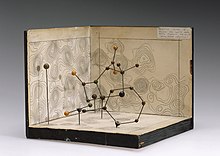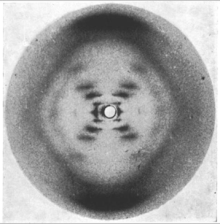User:CuriosityScribe/sandbox/crystal
Contribution of Women to X-Ray Crystallography
[edit]A number of women were pioneers in X-ray crystallography at a time when they were excluded from most other branches of physical science.[1]
Kathleen Lonsdale was a research student of William Henry Bragg, who with his son Lawrence founded the science of X-ray Crystallography at the beginning of the 20th century. Bragg had 11 women research students out of a total of 18. Kathleen joined his crystallography research team at the Royal Institution in London, in 1923 and after getting married and having children, went back to work with Bragg as a researcher. She confirmed the structure of the benzene ring, carried out studies of diamond, was one of the first two women to be elected to the Royal Society in 1945, and in 1949 was appointed the first female tenured professor of chemistry and head of the department of Crystallography at University College London.[2] Kathleen always advocated greater participation of women in science and said in 1970: “Any country that wants to make full use of all its potential scientists and technologists could do so, but it must not expect to get the women quite so simply as it gets the men. ... It is utopian, then, to suggest that any country that really wants married women to return to a scientific career, when her children no longer need her physical presence, should make special arrangements to encourage her to do so?”[3]. During this period, Kathleen began a collaboration with William T. Astbury on a set of 230 space group tables which was published in 1924 and became an essential tool for crystallographers.

In 1932 Dorothy Hodgkin joined the laboratory of the physicist John Desmond Bernal, who was a former Bragg student, in Cambridge, UK. She and Bernal took the first X-ray photographs of crystalline proteins. She was awarded the Nobel Prize in Chemistry in 1964 for her work using X-ray techniques to study the structures of penicillin, insulin and vitamin B12. She is the only British woman ever to have won a Nobel Prize in a science subject.

Rosalind Franklin took the X-ray photograph of a DNA fibre that proved key to James Watson and Francis Crick's discovery of the double helix, for which they both won the Nobel Prize for Physiology or Medicine in 1962. Watson revealed in his autobiographic account of the discovery of the structure of DNA, The Double Helix[4], that he had used Rosalind's x-ray photograph without her permission in his work in solving DNA's double helical structure. Franklyn died of cancer in her 30s, before Watson received the Nobel Prize. Franklyn also carried out important structural studies of carbon in coal and graphite, and of plant and animal viruses.
Isabella Karle of the United States Naval Research Laboratory developed an experimental approach to the mathematical theory of crystallography. Her work improved the speed and accuracy of chemical and biomedical analysis . Yet only her husband Jerome shared the 1985 Nobel Prize in Chemistry with Herbert Hauptman, “for outstanding achievements in the development of direct methods for the determination of crystal structures”. Other prize-giving bodies have showered Isabella with awards in her own right.
Women have written many textbooks and research papers in the field of X-ray crystallography. For many years Lonsdale edited the International Tables for Crystallography[5], which provide information on crystal lattices, symmetry and space groups, as well as mathematical, physical and chemical data on structures. Olga Kennard of the University of Cambridge, founded and ran the Cambridge Crystallographic Data Centre, an internationally recognized source of structural data on small molecules, from 1965 until 1997. Jenny Pickworth Glusker a British scientist, co-authored Crystal Structure Analysis: A Primer[6], first published in 1971 and now in its third edition (2010). Eleanor Dodson, an Australian born biologist, who began as Dorothy Hodgkin's technician, was the main instigator behind CCP4, the collaborative computing project that currently shares more than 250 software tools with protein crystallographers worldwide.
The International Union of Crystallography's online list[7] of eminent crystallographers is more than 90% male. Its prestigious Ewald Prize, awarded triennially since 1987, has had one female recipient (Eleanor Dodson) out of 14.
References
[edit]- ^ Kahr, Bart (2015-10-07). "Broader Impacts of Women in Crystallography". Crystal Growth & Design. 15 (10): 4715–4730. doi:10.1021/acs.cgd.5b00457. ISSN 1528-7483.
- ^ Ferry, Georgina (2014-01-30). "History: Women in crystallography". Nature News. 505 (7485): 609. doi:10.1038/505609a.
- ^ Sanz-Aparicio, Julia (2015-04-30). "The legacy of women to crystallography". Arbor. 191 (772): a216. doi:10.3989/arbor.2015.772n2002. ISSN 1988-303X.
- ^ 1928-, Watson, James D., (2000), Discovering the double helix, Cold Spring Harbor Laboratory, ISBN 978-0-87969-622-1, OCLC 48554849, retrieved 2021-06-04
{{citation}}:|last=has numeric name (help)CS1 maint: extra punctuation (link) CS1 maint: multiple names: authors list (link) - ^ International tables for crystallography. Wiley-Blackwell. 2011. doi:10.1107/97809553602060000001. ISBN 978-0-470-66078-2. OCLC 949744995.
- ^ Glusker,, Jenny Pickworth,. Crystal structure analysis : a primer. ISBN 0-19-191790-7. OCLC 1241842166.
{{cite book}}: CS1 maint: extra punctuation (link) CS1 maint: multiple names: authors list (link) - ^ "(IUCr) Biographical notes on individual crystallographers". www.iucr.org. Retrieved 2021-06-02.
